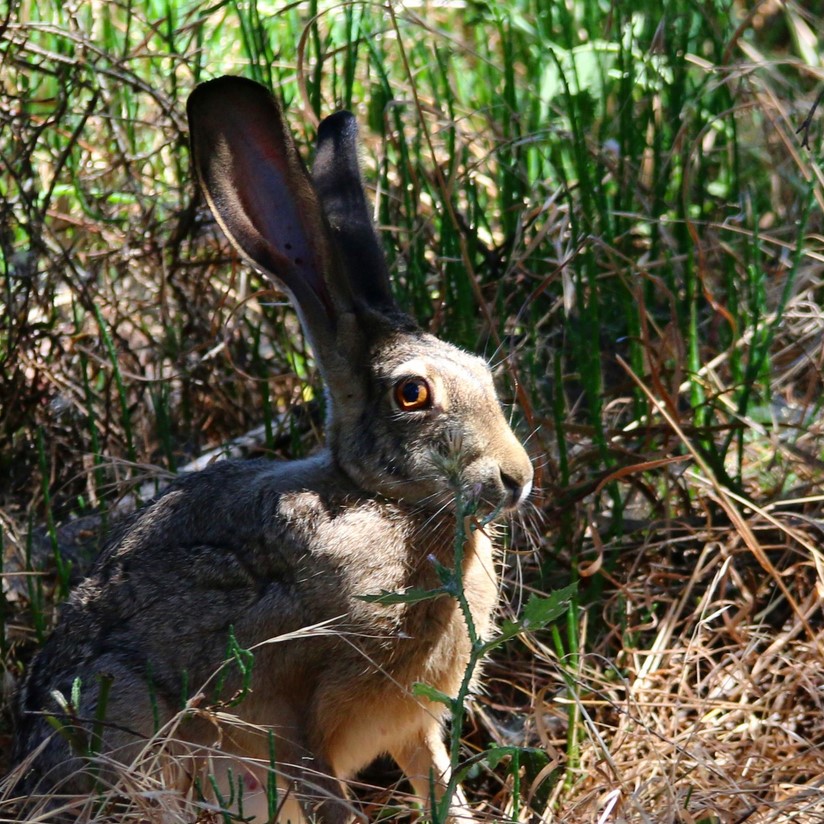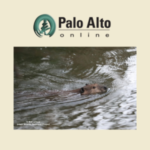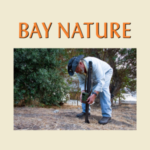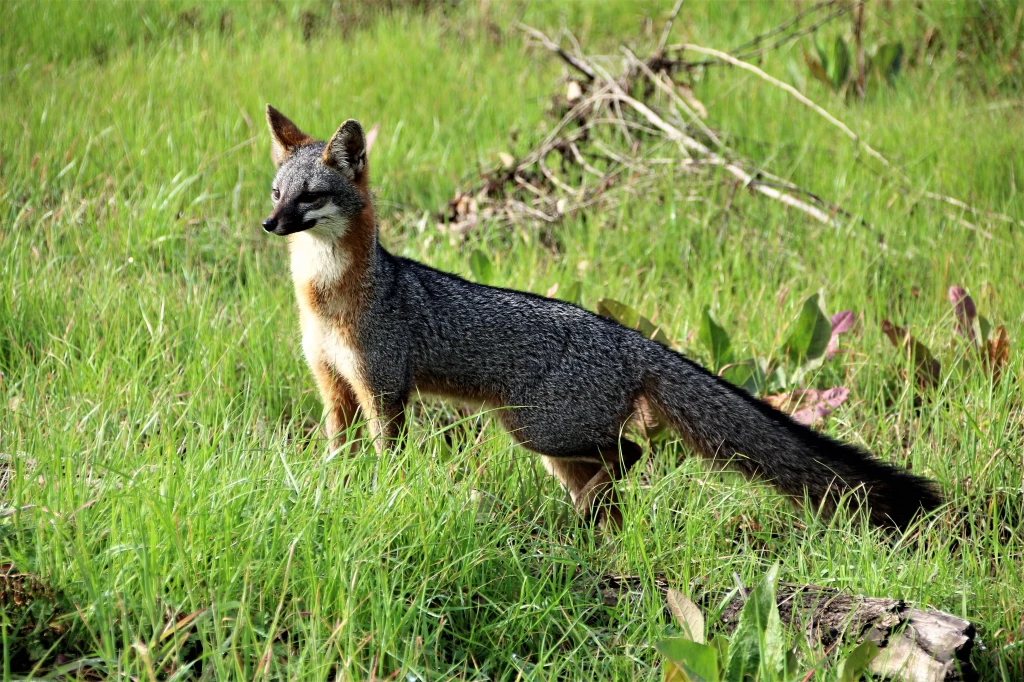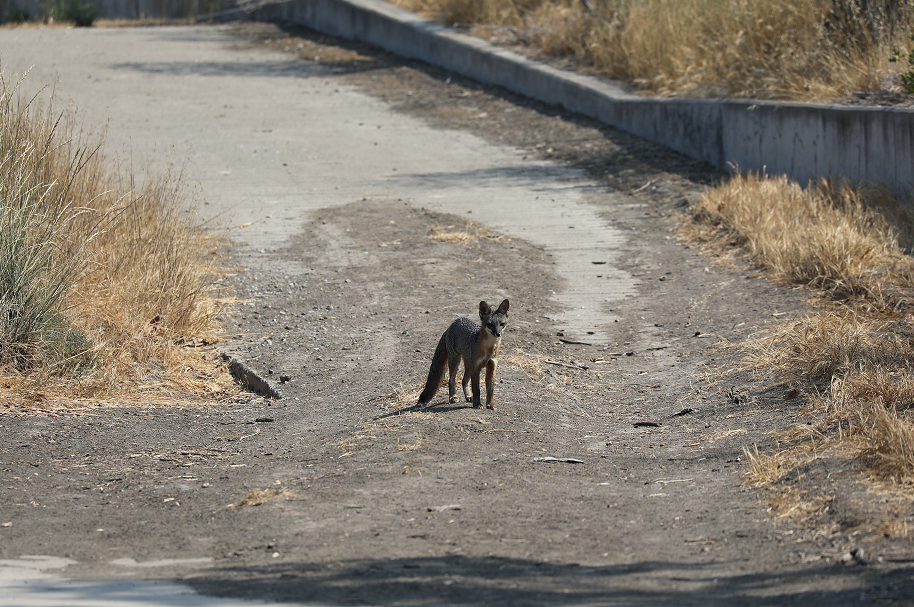Mama Jack Rabbit, Owls, and Thieves
by William C. Leikam
President, CEO & Co-founder, Urban Wildlife Research Project
Mama Jack Rabbit:
In all the years that I have had trail cameras running at the Palo Alto Baylands Preserve, never until now have I ever seen a mama jack rabbit and her babies. Over the past couple of weeks, every night at between 9:00 and 9:30, mama jack rabbit hops into view of the trail camera. She sits just at the edge of the weeds and her two little ones run out to meet her, nurse, and then run back into the brush.
That continued until this week (May 22 – 27, 2023) when once the two baby rabbits have finished nursing, one of them will dash back into the weeds while the other one will often dash after mama rabbit. This morning, however, a change occurred. When the two babies had finished nursing, mama jack rabbit dashed off to the right. Both of her babies ran after her. A little while later, they came running from off the right across to the left and out along Perimeter Road. They are growing up and mighty fast at that.
Owls:
Camera #8 is set up down in Fox Hollow near the gate, beneath a barn owl box where a pair of young owls live. Much of the night when they are in the area, they keep watch from up in the eucalyptus trees on Fox Hollow Hill and listen for the rustling of tiny feet in the grass below. They are also on the lookout for any predator that might come into the area. When they see one, (say for instance when the gray foxes Laimos and Big Eyes have come on over to hunt near the water treatment plant from Matadero Creek,) the barn owls send out a distinctive series of screeches warning all other animals in the region that predator is on the prowl.
When processing the night’s files from off the SD cards, I listen to the ambient sounds picked up by the trail cameras. Even if the predator is not passing by a camera, I know that either the foxes or the coyote pair is in the neighborhood. I always tell people, “Listen to the birds, especially the crows and raven. There’s more happening there than you might think.”
And Thieves:
Over the years our trail cameras have been vandalized by what I can only see as angry people. These people tend to steal. In one such incident around 2019, the person who stole that camera had to climb down a rather steep slope to find it, took it down off its special post, and then bent the post all the way to the ground thus breaking spike that kept it in the ground. It was violent.
Most recently, camera #6 was stolen on May 21st, 2023 – This theft took place in the big clearing area where no one should have been. As I walked toward that area that morning, I noticed that some of the fennel along Cute’s Trail had been intentionally broken. When I came down into the inner channel, I found that the person had broken the young willow trees that grew on the side of the trail. Once I came into the big clearing, it was obvious that the person did not know the trail that I use because it is overgrown by weeds. The thief had trampled the weeds off trail.
At that point I had very little hope that I’d find camera #6 in-place. As I came along Blackberry Trail I looked ahead. No camera standing there on its post. Even the camera post was gone. I looked around and found it had been tossed off into the weeds, so I hid it at the entrance to the thicket. This must have been an angry person who was taking out his anger on the vegetation and my trail camera.
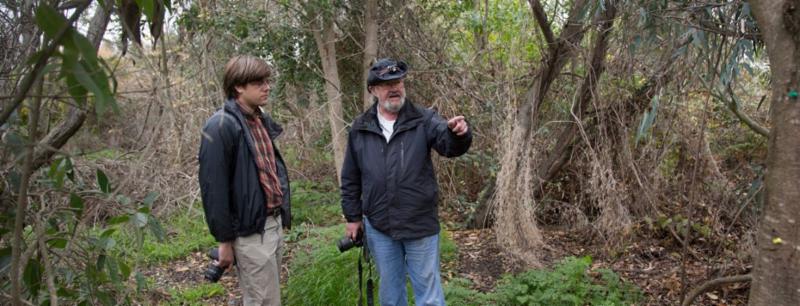
I. Gray Fox Population & General Health
As of this date, we have two adult gray foxes living in the Palo Alto Baylands Nature Preserve. These two foxes appear to be in good health. There is no indication in their scat that anything internal is breaking down.
However, Laimos is head-shaking once again. I’m not sure what that all means. It seems to come on at only this time of year.
II. UWRP News & Updates
 The ‘Triggered By Motion’ Experience
The ‘Triggered By Motion’ Experience
The UWRP is excited to present our newest video documentary featuring Bill Leikam’s participation in the global research project “Triggered By Motion”, a world-wide exhibit of citizen scientists from 21 locations using camera traps to learn about local urban wildlife. Join Bill on his journey between California and Zürich, Switzerland, as he experiences the breathtaking exhibition in person!
The UWRP has just launched a brand new website, courtesy of Milena at DesignerForChange. Please visit us at our new domain, urbanwildliferesearchproject.org (not .com!) to stay in the loop on our conservation activity, event announcements, and updates about gray foxes Big Eyes and Laimos in the Palo Alto Baylands.
Today, Bill is the world’s leading authority on the gray fox. This book is an account of his experiences among the gray foxes of the Baylands, a tale of life and death, of growth and loss. Stay for a while and go exploring with the Fox Guy. Find it today at Barnes & Noble or DiAngelo Publications.
 Coming soon:
Coming soon:
Look forward to an upcoming interview between Bill and Dr. Annabelle Dufourcq, associate professor of metaphysics and philosophical anthropology, philosophy, theology and religious studies at Radboud University Nijmegen, The Netherlands — for a project of hers on ethology.
Read more about UWRP in the news:
III. UWRP Research Objectives
Within the permit that allows the Urban Wildlife Research Project to conduct its study of the behavior of the gray fox at the Palo Alto Baylands Nature Preserve, the objectives covered area:
Monitoring of urban gray fox denning sites in Palo Alto Baylands: This is being accomplished during the period when the gray foxes use a den site. It is one of the prime locations for gathering most of the behavioral data of the litter and for adults alike.
Assessment of status and population trends of Baylands urban gray foxes: Since January 2019 a pair of resident gray foxes have claimed territory at the Palo Alto Baylands Nature Preserve.
Identification of habitat features that promote the presence of urban gray foxes: After considering this and talking with people who know how to restore habitats, we need to assess what kinds of plants, including the Alkaline Saltbush, would grow best along the edge of the saltwater channel and alongside the marsh. We need to grow a permanent habitat that contains the corridors and plant it as soon as possible. We’ll keep an eye on this as this is a critical link between the southern region of the Baylands and the northern region.
Assessment of reproductive success and identification of factors that promote successful reproduction: Open the pinch-point along Matadero Creek by developing thickets that link one area to another, instead of the present “islands”.
Identification and assessment of possible dispersal travel routes: Dispersal routes move between the Palo Alto Baylands Nature Preserve and the Shoreline region over in Mountain View. In a north-westerly direction the dispersal corridors run just behind the homes bordering the marshlands.

